1993 CADILLAC SEVILLE brake fluid
[x] Cancel search: brake fluidPage 118 of 407
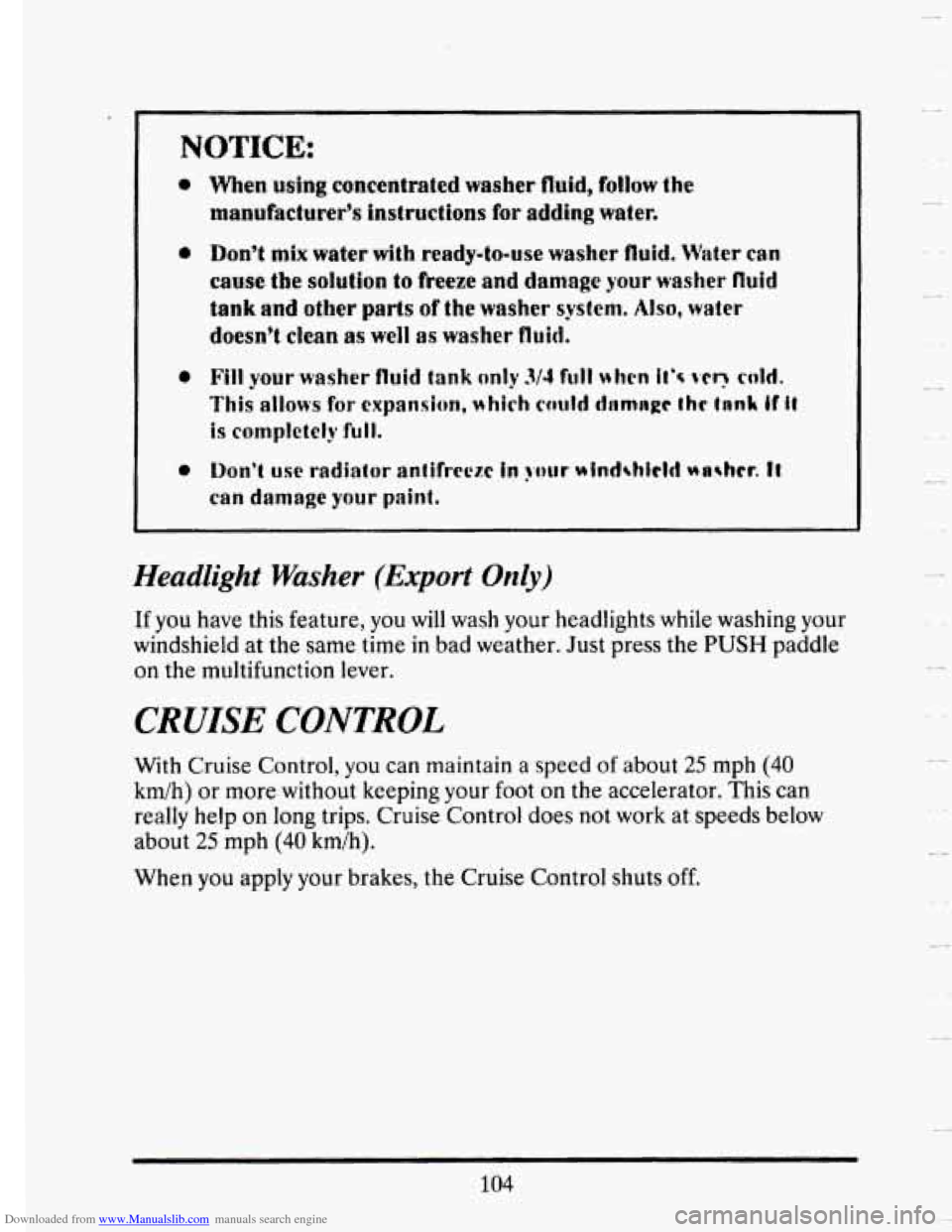
Downloaded from www.Manualslib.com manuals search engine NOTICE:
*
0
e
Men using concentrated washer fluid, follow the
manufacturer’s fnstcuctions for adding water.
Don’t mix water with readyto-use washer fluid, Water can
cause the solution to freeze and damage your washer fluid
tank and other parts of the washer system. Also, water
doesn’t clean as well as washer fluid.
Fill your washer fluid tank only 3/4 full $5 hen it’s vt~ cold.
This allows for expansion, which could dnmngc thc tank if it
is completely full.
Don’t use radiator antifrcezc in your uind4Md wathcr. It
can damage your paint.
Headlight Washer (Export Only)
If you have this feature, you will wash your headlights while washing your
windshield at the same
time in bad weather. Just press the PUSH paddle
on the multifunction lever.
CRUISE CONTROL
With Cruise Control, you can maintain a speed of about 25 mph (40
km/h) or more without keeping your foot on the accelerator. This can
really help on long trips. Cruise Control does not work
at speeds below
about
25 mph (40 km/h).
t-r
When you apply your brakes, the Cruise Control shuts off.
104
Page 152 of 407
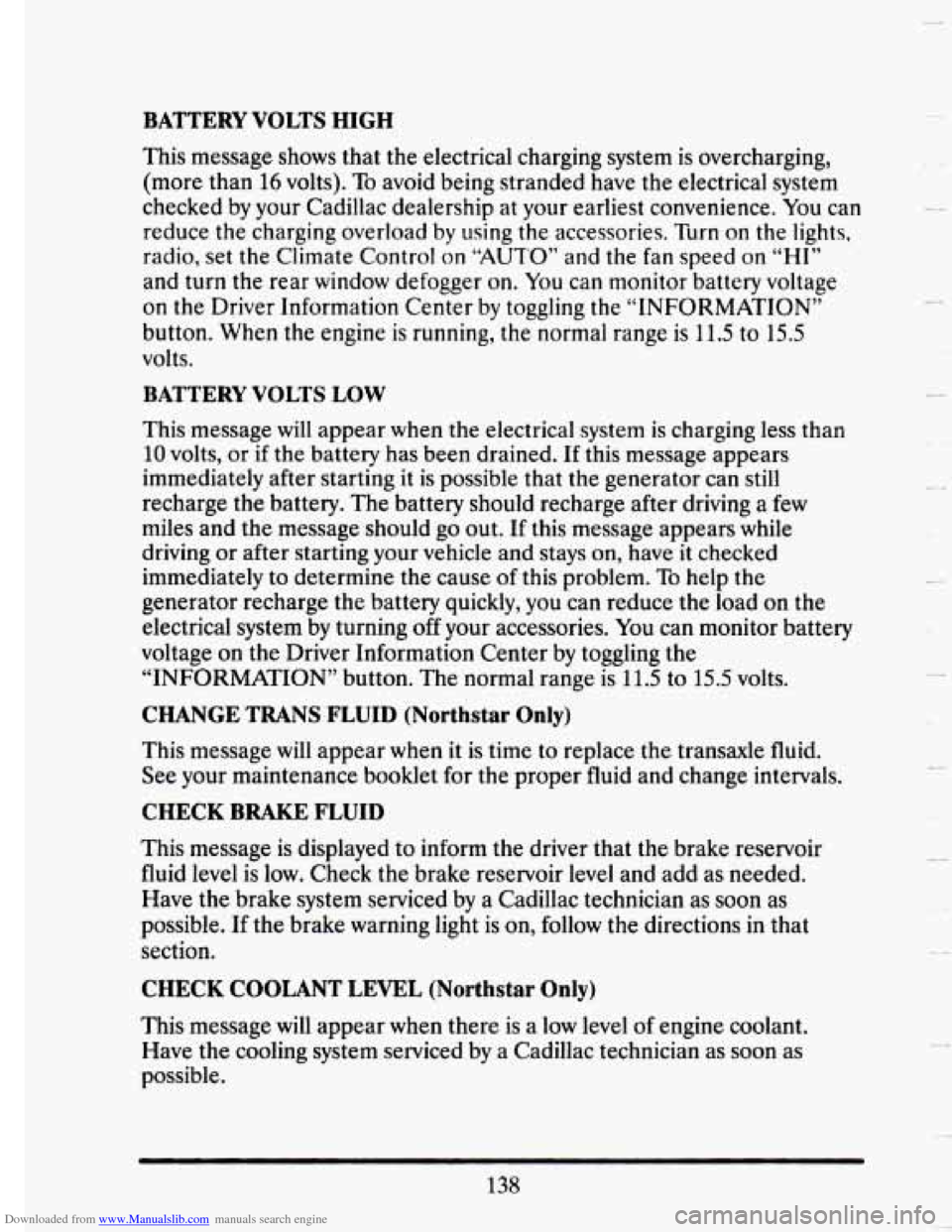
Downloaded from www.Manualslib.com manuals search engine BATTERY VOLTS HIGH
This message shows that the electrical charging system is overcharging,
(more than 16 volts). To avoid being stranded have the electrical system
checked by your Cadillac dealership at your earliest convenience. You can
reduce the charging overload
by using the accessories. Turn on the lights,
radio, set the Climate Control on
“AUTO” and the fan speed on “HI”
and turn the rear window defogger on. You can monitor battery voltage
on the Driver Information Center by toggling the “INFORMATION”
button. When the engine is running, the normal range
is 11.5 to 15.5
volts.
c
BATTERY VOLTS LOW
This message will appear when the electrical system is charging less than
10 volts, or if the battery has been drained. If this message appears
immediately after starting it is possible that the generator can still
recharge the battery. The battery should recharge after driving a few
miles and the message should go out. If this message appears while
driving or after starting your vehicle and stays on, have it checked
immediately to determine the cause
of this problem. To help the
generator recharge the battery quickly,
you can reduce the load on the
electrical system by turning
off your accessories. You can monitor battery
voltage on the Driver Information Center by toggling the
“INFORMATION’’ button. The normal range is
11.5 to 15.5 volts.
CHANGE TRANS FLUID (Northstar Only)
This message will appear when it is time to replace the transaxle fluid.
See your maintenance booklet
for the proper fluid and change intervals.
CHECK BRAKE FLUID
This message is displayed to inform the driver that the brake reservoir
fluid level is low. Check the brake reservoir level and add as needed.
Have the brake system serviced by a Cadillac technician as soon as
possible.
If the brake warning light is on, follow the directions in that
section.
CHECK COOLANT LEVEL (Northstar Only)
This message will appear when there is a low level of engine coolant.
Have the cooling system serviced by a Cadillac technician as soon as
possible.
138
I
. -’
L
c
Page 215 of 407
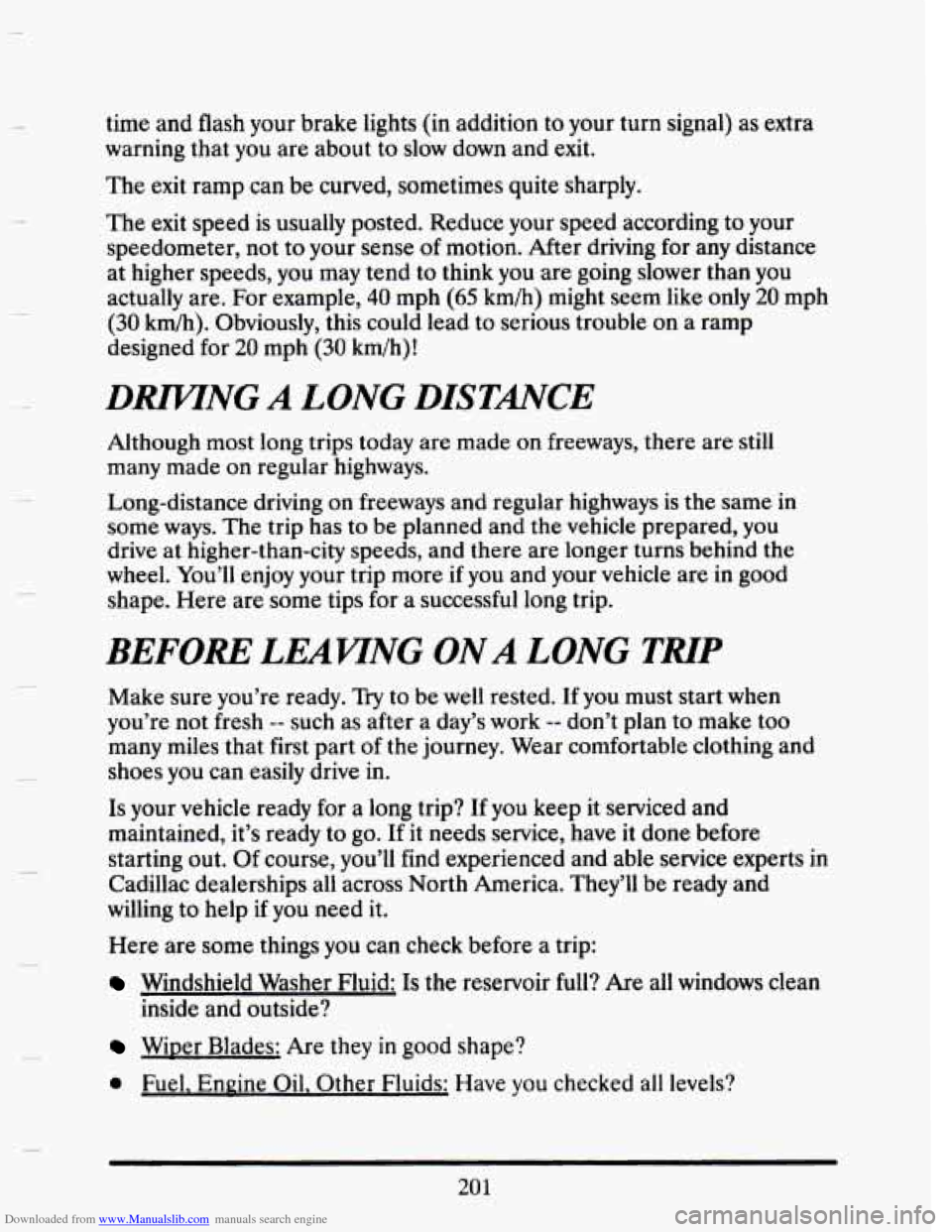
Downloaded from www.Manualslib.com manuals search engine time and flash your brake lights (in addition to your turn signal) as extra
warning that you are about to slow down and exit.
The exit ramp can be curved, sometimes quite sharply.
The exit speed is usually posted. Reduce your speed according
to your
speedometer, not to your sense
of motion. After driving for any distance
at higher speeds, you may tend to think you are going slower than you
actually are. For example,
40 mph (65 km/h) might seem like only 20 mph
(30 km/h). Obviously, this could lead to serious trouble on a ramp
designed for
20 mph (30 km/h)!
DMNG A LONG DISTANCE
Although most long trips today are made on freeways, there are still
many made
on regular highways.
Long-distance driving on freeways and regular highways is the same
in
some ways. The trip has to be planned and the vehicle prepared, you
drive at higher-than-city speeds, and there are longer turns behind
the
wheel. You’ll enjoy your trip more if you and your vehicle are in good
shape. Here are some tips for a successful long trip.
BEFORE LEAWNG ONA LONG THP
Make sure you’re ready. Try to be well rested. If you must start when
you’re not fresh
-- such as after a day’s work -- don’t plan to make too
many miles that first part of
the journey. Wear comfortable clothing and
shoes
you can easily drive in.
Is your vehicle ready for a long trip? If you keep it serviced and
maintained, it’s ready to
go. If it needs service, have it done before
starting out. Of course, you’ll find experienced and able service experts
in
Cadillac dealerships all across North America. They’ll be ready and
willing to help
if you need it.
Here are some things
you can check before a trip:
Windshield Washer Fluid: Is the reservoir full? Are all windows clean
inside and outside?
Wiper Blades: Are they in good shape?
0 Fuel. Enpine Oil. Other Fluids: Have you checked all levels?
201
Page 218 of 407
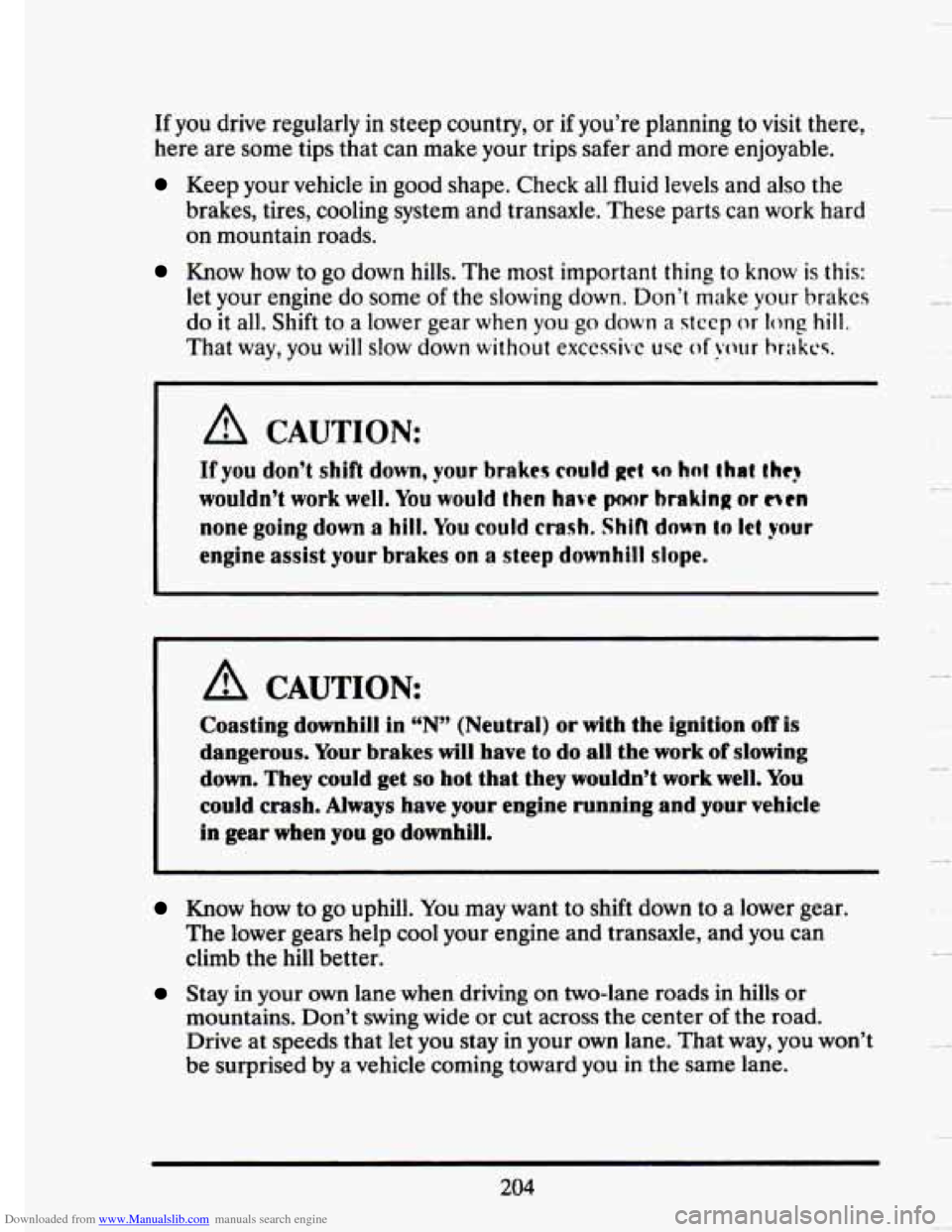
Downloaded from www.Manualslib.com manuals search engine If you drive regularly in steep country, or if you’re planning to visit there,
here are some tips that can make your trips safer and more enjoyable.
Keep your vehicle in good shape. Check all fluid levels and also the
brakes, tires, cooling system and transaxle. These parts can work hard
on mountain roads.
Know how to go down hills. The most important thing to know is this:
let your engine do some of the slowing down. Don’t make your brakes
do it all. Shift to a lower gear when you go down a stcep or long hill.
That way, you will slow down without excessive we of !wr hrilkcs.
I
A CAUTION:
If you don’t shift down, your brakes could get so hot that tht?
wouldn’t work well. You would then have pr braking or men
none going down a hill. You could crash. Shin down to let your
engine assist your brakes on a steep downhill slope.
A CAUTION
Coasting downhill in “N” (Neutral) or with the ignition off is
dangerous. Your brakes will have
to do all the work of slowing
down. They could get
so hot that they wouldn’t work well. You
could crash. Always have your engine running and your vehicle
in
gear when you go downhill.
Know how to go uphill. You may want to shift down to a lower gear.
The lower gears help cool your engine and transaxle, and you can
climb the hill better.
Stay in your own lane when driving on two-lane roads in hills or
mountains. Don’t swing wide or cut across the center
of the road.
Drive at speeds that let you
stay in your own lane. That way, you won’t
be surprised
by a vehicle coming toward you in the same lane.
204
Page 233 of 407
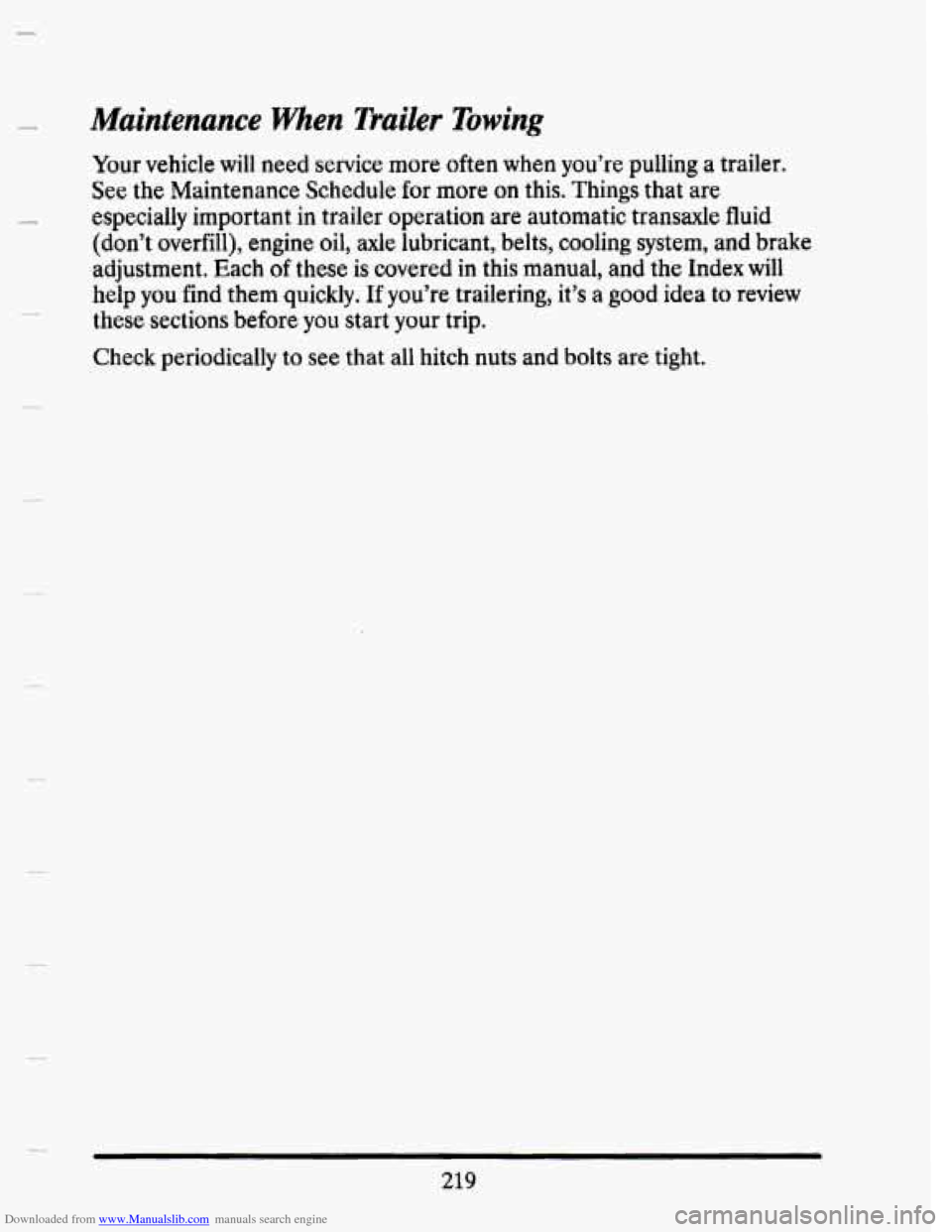
Downloaded from www.Manualslib.com manuals search engine Maintenance when Trailer Towing
Your vehicle will need service more often when you’re pulling a trailer.
See the Maintenance Schedule for more on this. Things that are
especially important
in trailer operation are automatic transaxle fluid
(don’t overfill), engine oil, axle lubricant, belts, cooling system, and brake
adjustment. Each
of these is covered in this manual, and the Index will
help you find them quickly. If you’re trailering, it’s a good idea to review
these sections before you start your trip.
Check periodically to see that all hitch nuts and bolts are tight.
219
Page 293 of 407
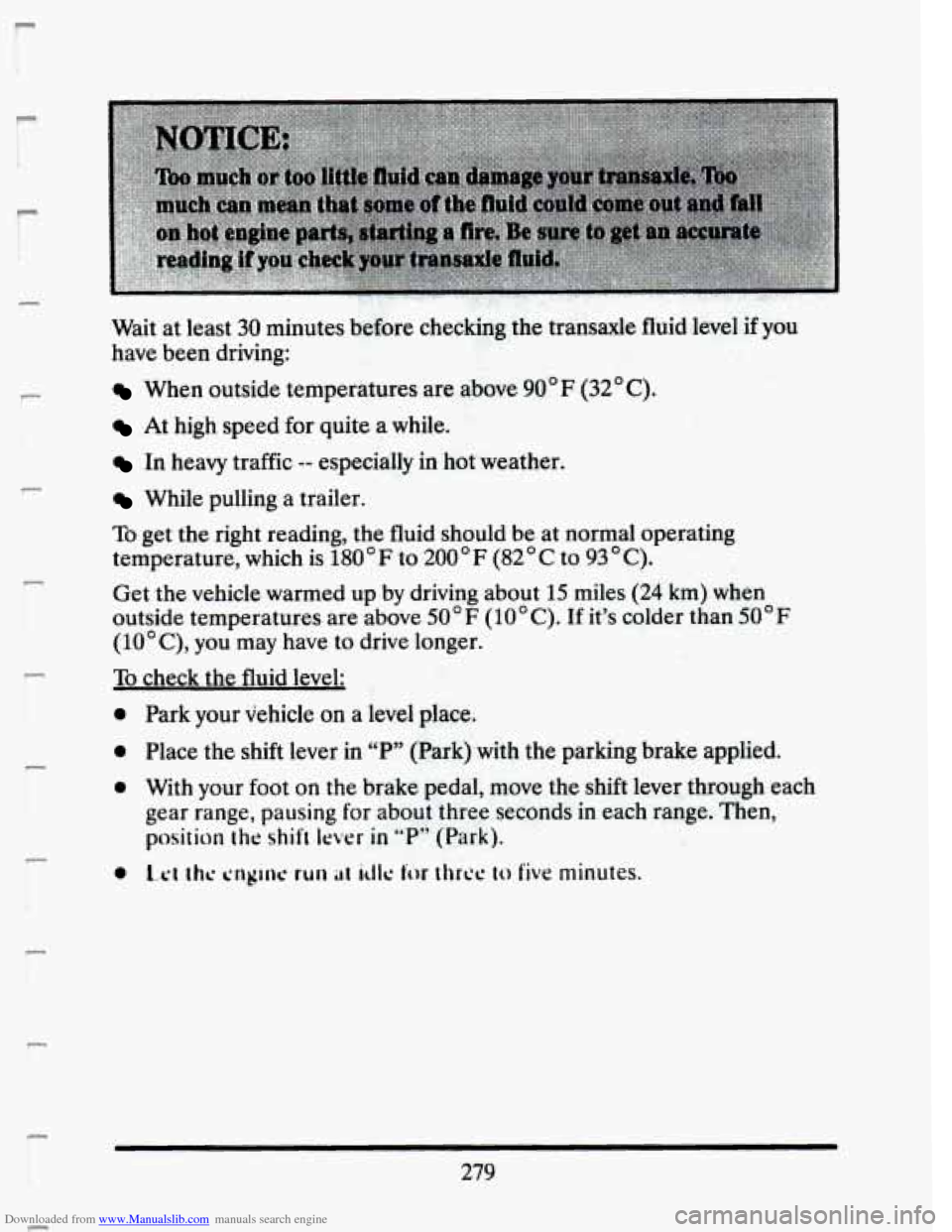
Downloaded from www.Manualslib.com manuals search engine 1“
P
Wait at least 30 minutes &ore checking the transaxle fluid level if you
have been driving:
When outside temperatures are above 90’F (32’ C).
At high speed for quite a while.
In heavy traffic -- especially in hot weather.
While pulling a trailer.
To get the right reading, the fluid should be at normal operating
temperature, which is
180°F to 200°F (82OC to 93’C).
Get the vehicle warmed up
by driving about 15 miles (24 km) when
outside temperatures are above
5O0F (loo C). If it’s colder than 5OoF
(lO°C), you
may have to drive longer.
To check the fluid level:
0
0
0
0
Park your vehicle on a level place.
Place the shift lever in
“PYy (Park) with the parking brake applied.
With your foot
on the brake pedal, move the shift lever through each
gear range, pausing
for about three. seconds in each range, Then,
position
the shift lever in “P” (Park).
L-ct Ihc cngirlr ruI1 ;II idlc for thrw to five minutes.
F
P
279
Page 304 of 407

Downloaded from www.Manualslib.com manuals search engine NOTICE:
e When using eoncentrated washer fluid, follow the
manufacturer inStructfons for adding water.
Don't mix water with ready to use washer fluid. Water can
cause the solution to freeze and damage your washer fluid
tank and other parts of the washer system. Also, water
doesn't clean as well as washer fluid.
Fill your washer fluid tank only 3/4 full when it's very cold.
This allows for expansion, which could darnage the tank if it
is completely full.
Don't use radiator antifreeze in pout wlndshicld wuadwr. It
can damage your paint.
r
BW MSTER CYZINDER
Your brake master cylinder is here. It is filled with DOT-3 brake fluid.
290
Page 305 of 407
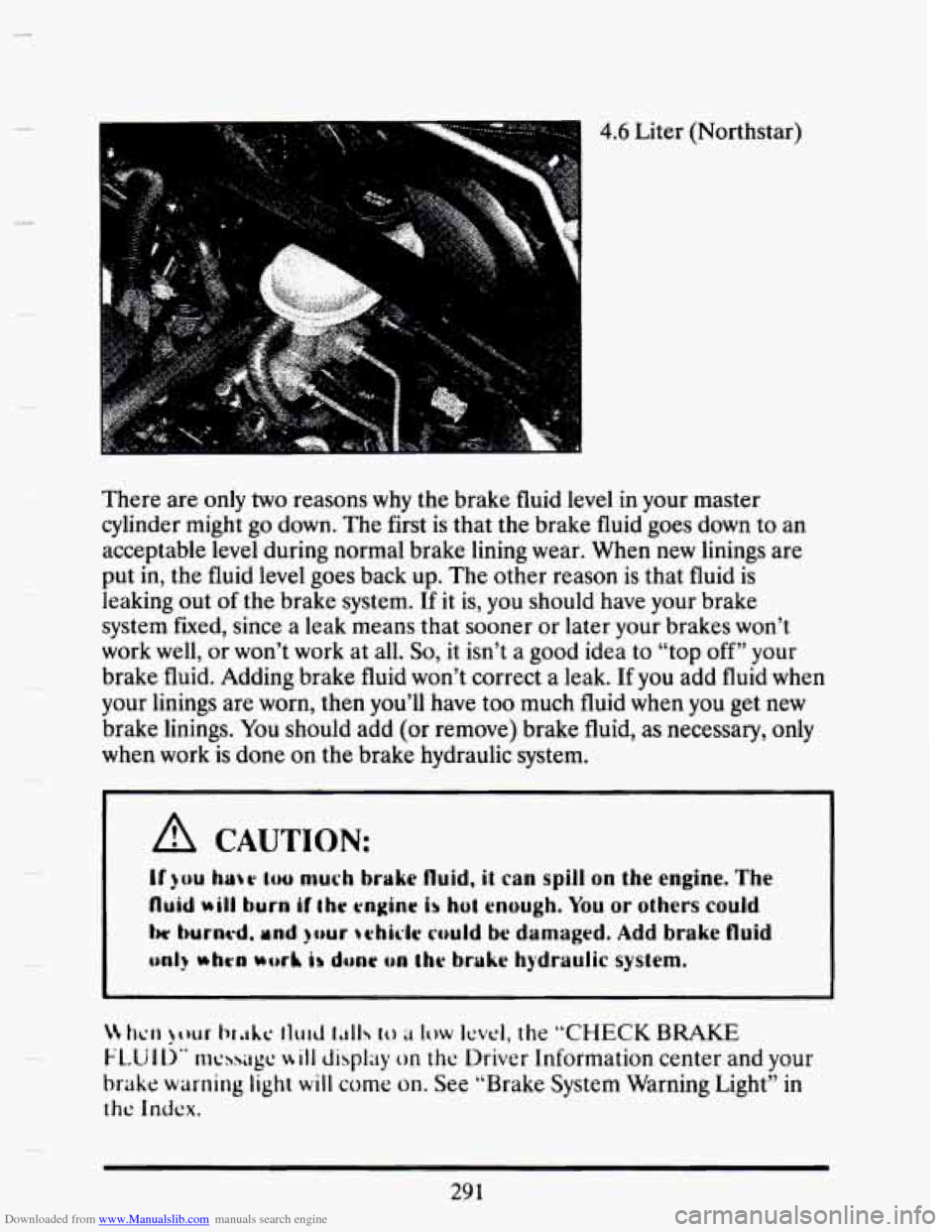
Downloaded from www.Manualslib.com manuals search engine There are only two reasons why the brake fluid level in your master
cylinder might go down. The first is that the brake fluid goes down to an
acceptable level during normal brake lining wear. When
new linings are
put in, the fluid level goes back up. The other reason is that fluid is
leaking out
of the brake system. If it is, you should have your brake
system
fixed, since a leak means that sooner or later your brakes won’t
work well, or won’t work at all.
So, it isn’t a good idea to “top off” your
brake fluid. Adding brake fluid won’t correct a leak. If you add fluid when
your linings are worn, then you’ll have too much fluid when you get new
brake linings.
You should add (or remove) brake fluid, as necessary, only
when work
is done on the brake hydraulic system.
A CAUTION:
If ),ou hate loo much brake fluid, it can spill on the engine. The
fluid will burn if the engine is hot enough. You or others could
tw borntd. and )our whicle could be damaged. Add brake fluid
onl) whco wcC h dune on the bruke hydraulic system.
\C hc‘n !our tmk tlu~cj 1,1115 10 ;I Iuw Icvel, the “CHECK BRAKE
FLU ID” ~nc~gc L+ ill display on the Driver Information center and your
brake warning light will come on. See “Brake System Warning Light” in
the Index.
291